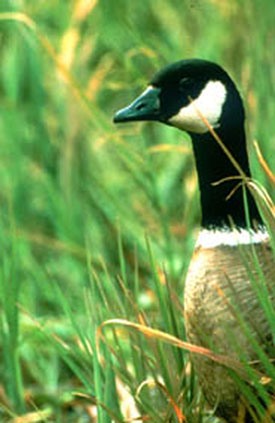- Cackling Goose
Taxobox
name = Cackling Goose
status = LC | status_system = IUCN3.1

image_width = 240px
image_caption = Aleutian Cackling Goose
"Branta hutchinsii leucopareia"
regnum =Animal ia
phylum = Chordata
classis = Aves
ordo =Anseriformes
familia =Anatidae
genus = "Branta "
species = "B. hutchinsii"
binomial = "Branta hutchinsii"
binomial_authority = (Richardson, 1832)
synonyms = "Branta canadensis hutchinsii"
subdivision_ranks =Subspecies
subdivision =
* "B. h. hutchinsii" Richardson's Cackling Goose
* "B. h. asiatica"Bering Cackling Goose (disputed;extinct )
* "B. h. leucopareia"Aleutian Cackling Goose
* "B. h. taverneri" Taverner's Cackling Goose
* "B. h. minima" Small Cackling GooseThe Cackling Goose ("Branta hutchinsii"), colloquially (and incorrectly) Lesser or Small Canada/Canadian Goose in
North America , belongs to thegenus "Branta" of black geese, which containsspecies with largely black plumage, distinguishing them from the grey "Anser" species.The black head and neck with white "chinstrap" distinguish this goose from all except the larger
Canada Goose ("Branta canadensis") and the similarly sizedBarnacle Goose ("B. leucopsis"). There are up to 5subspecies of Cackling Goose, of varying sizes and plumage details. Some are hard to distinguish from the Canada Goose, with which the Cackling Goose was long assumed to form one species, and the name Lesser Canada Goose properly denotes the subspecies "parvipes" of the Canada Goose. The distinctness of the extinct population of the Komandorski andKuril Islands "B. h. asiatica" is controversial. The Barnacle Goose differs in having a black breast and grey, rather than brownish, body plumage.This species is native to
North America . It breeds in northernCanada andAlaska in a variety oftundra habitats. However, the nest is usually located in an elevated area near water. The eggs are laid in a shallow depression lined with plant material and down. Males can be very aggressive in defending territory. A pair may mate for life (up to around 20 years). The female looks virtually identical but is slightly lighter and has a different voice. Adult geese are often seen leading their goslings in a line with one parent at the front, and the other at the back of the "parade".Like most geese, it is naturally migratory, the wintering range being most of the U.S.A., and locally in western Canada and northern
Mexico . The calls overhead from large groups of Cackling Geese flying in V-shaped formation signal the transitions into spring and fall. In some areas, migration routes have changed due to changes in habitat and food sources.Cackling Geese have occasionally reached western
Europe naturally, as has been proved by ringing recoveries. The birds are of at least the subspecies "hutchinsii", and possibly others. Cackling Geese are also found naturally on occasions in theKamchatka Peninsula in easternSiberia , easternChina , and throughoutJapan .These birds feed mainly on plant material. When feeding in water, they submerge their heads and necks to reach aquatic plants, sometimes tipping forward like a
dabbling duck . Flocks of these birds often feed on leftover cultivated grains in fields, especially during migration or in winter. They also eat someinsect s,mollusc s andcrustacean s.By the early 20th century, over-hunting and loss of habitat in the late 1800s and early 1900s had resulted in a serious decline in the numbers of this bird in its native range. With improved game laws and habitat recreation and preservation programs, their populations have recovered in most of their range, although some local populations may still be declining, especially of the subspecies "minima" and "leucopareia". Though the taxonomic distinctness of the Komandorski and Kuril Islands populations, which used to winter in Japan, is controversial, it is without doubt that they disappeared around 1929.
ystematics
The Cackling Goose was originally considered to be the same species or a subspecies of the
Canada Goose , but in July 2004 theAmerican Ornithologists' Union 's Committee on Classification and Nomenclature split the two into two species, making Cackling Goose into a full species with the scientific name "Branta hutchinsii". TheBritish Ornithologists Union followed suit in June 2005.The AOU has divided the many associated
subspecies between both animals. To the present species were assigned:*Richardson's Cackling Goose ("Branta hutchinsii hutchinsii")
*Aleutian Cackling Goose ("Branta hutchinsii leucopareia")
*Small Cackling Goose ("Branta hutchinsii minima")
*part of "Lesser complex" ("Branta hutchinsii taverneri")
*Bering Cackling Goose ("Branta hutchinsii asiatica") - doubtfully distinct from "B. h. leucopareia";extinct (c.1929)The distinctions between the two geese have led to a great deal of confusion and debate among ornithologists. This has been aggravated by the overlap between the small types of Canada Goose and larger types of Cackling Goose. Most interestingly, the old "Lesser Canada Goose" was believed to be a partly hybrid population, with the birds named "taverneri" considered a mixture of "minima", "occidentalis" and "parvipes". In addition, it has been determined that the
Barnacle Goose is a derivative of the Cackling Goose lineage, whereas theHawaiian Goose is an insular representative of the Canada Goose.For more information on the subject, see the following:
*Stackhouse, Mark. [http://www.utahbirds.org/RecCom/NewGoose.htm The New Goose] .
*Angus, Wilson. [http://www.oceanwanderers.com/CAGO.Subspecies.html Identification and range of subspecies within the Canada and Cackling Goose Complex ("Branta canadensis" & "B. hutchinsii")] .
*Moser, Timothy J., Craven, Scott R. and Miller, Brian K. [http://www.ces.purdue.edu/extmedia/FNR/FNR-129.html Canada Geese in the Mississippi Flyway: A Guide for Goose Hunters and Goose Watchers] .References
*
Wikimedia Foundation. 2010.
